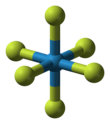Tungsten hexafluoride
 Solid WF6 melting into liquid WF6
| |||
| |||
| Names | |||
|---|---|---|---|
| IUPAC names
Tungsten hexafluoride
Tungsten(VI) fluoride | |||
| Identifiers | |||
3D model (JSmol)
|
|||
| ECHA InfoCard | 100.029.117 | ||
| EC Number |
| ||
PubChem CID
|
|||
| UNII | |||
| UN number | 2196 | ||
CompTox Dashboard (EPA)
|
|||
| |||
| |||
| Properties | |||
| WF6 | |||
| Molar mass | 297.830 g/mol | ||
| Appearance | Colorless gas | ||
| Density | 12.4 g/L (gas) 4.56 g/cm3 (−9 °C, solid) | ||
| Melting point | 2.3 °C (36.1 °F; 275.4 K) | ||
| Boiling point | 17.1 °C (62.8 °F; 290.2 K) | ||
| Hydrolyzes | |||
| −40.0·10−6 cm3/mol | |||
| Structure | |||
| Octahedral | |||
| zero | |||
| Hazards | |||
| Occupational safety and health (OHS/OSH): | |||
Main hazards
|
Toxic, corrosive; gives HF on contact with water | ||
| GHS labelling:[1] | |||
 
| |||
| Danger | |||
| H301+H311, H314, H330 | |||
| P260, P264, P264+P265, P270, P271, P280, P284, P301+P316, P301+P330+P331, P302+P352, P302+P361+P354, P304+P340, P305+P354+P338, P316, P317, P320, P321, P330, P361+P364, P363, P403+P233, P405, P410+P403, P501 | |||
| NFPA 704 (fire diamond) | |||
| Flash point | Non-flammable | ||
| Safety data sheet (SDS) | ChemAdvisor | ||
| Related compounds | |||
Other anions
|
Tungsten hexachloride Tungsten hexabromide | ||
Other cations
|
Chromium(VI) fluoride Molybdenum(VI) fluoride | ||
Related compounds
|
Tungsten(IV) fluoride Tungsten(V) fluoride | ||
Except where otherwise noted, data are given for materials in their standard state (at 25 °C [77 °F], 100 kPa).
| |||
Tungsten(VI) fluoride, also known as tungsten hexafluoride, is an inorganic compound with the formula WF6. It is a toxic, corrosive, colorless gas, with a density of about 13 kg/m3 (22 lb/cu yd) (roughly 11 times heavier than air).[2][3] It is the only known gaseous transition metal (or d-block) compound and the densest known gas under standard ambient temperature and pressure (298 K, 1 atm).[4] WF6 is commonly used by the semiconductor industry to form tungsten films, through the process of chemical vapor deposition. This layer is used in a low-resistivity metallic "interconnect".[5] It is one of seventeen known binary hexafluorides.
Properties
[edit]The WF6 molecule is octahedral with the symmetry point group of Oh. The W–F bond distances are 183.2 pm.[6] Between 2.3 and 17 °C, tungsten hexafluoride condenses into a colorless liquid having the density of 3.44 g/cm3 at 15 °C.[7] At 2.3 °C it freezes into a white solid having a cubic crystalline structure, the lattice constant of 628 pm and calculated density 3.99 g/cm3. At −9 °C this structure transforms into an orthorhombic solid with the lattice constants of a = 960.3 pm, b = 871.3 pm, and c = 504.4 pm, and the density of 4.56 g/cm3. In this phase, the W–F distance is 181 pm, and the mean closest molecular contacts are 312 pm. Whereas WF6 gas is one of the densest gases, with the density exceeding that of the heaviest elemental gas radon (9.73 g/L), the density of WF6 in the liquid and solid state is rather moderate.[8] The vapor pressure of WF6 between −70 and 17 °C can be described by the equation
- log10 P = 4.55569 − 1021.208/ T + 208.45,
where the P = vapor pressure (bar), T = temperature (°C).[9][10]
Synthesis
[edit]Tungsten hexafluoride is commonly produced by the exothermic reaction of fluorine gas with tungsten powder at a temperature between 350 and 400 °C:[7]
- W + 3 F2 → WF6
The gaseous product is separated from WOF4, a common impurity, by distillation. In a variation on the direct fluorination, the metal is placed in a heated reactor, slightly pressurized to 1.2 to 2.0 psi (8.3 to 13.8 kPa), with a constant flow of WF6 infused with a small amount of fluorine gas.[11]
The fluorine gas in the above method can be substituted by ClF, ClF3 or BrF3. An alternative procedure for producing tungsten fluoride is to react tungsten trioxide (WO3) with HF, BrF3 or SF4. Tungsten hexafluoride can also be obtained by conversion of tungsten hexachloride:[4]
- WCl6 + 6 HF → WF6 + 6 HCl or
- WCl6 + 2 AsF3 → WF6 + 2 AsCl3 or
- WCl6 + 3 SbF5 → WF6 + 3 SbF3Cl2
Reactions
[edit]On contact with water, tungsten hexafluoride gives hydrogen fluoride (HF) and tungsten oxyfluorides, eventually forming tungsten trioxide:[4]
- WF6 + 3 H2O → WO3 + 6 HF
Unlike some other metal fluorides, WF6 is not a useful fluorinating agent nor is it a powerful oxidant. It can be reduced to the yellow WF4.[12]
WF6 forms a variety of 1:1 and 1:2 adducts with Lewis bases, examples being WF6(S(CH3)2), WF6(S(CH3)2)2, WF6(P(CH3)3), and WF6(py)2.[13]
Applications in semiconductor industry
[edit]The dominant application of tungsten fluoride is in semiconductor industry, where it is widely used for depositing tungsten metal in a chemical vapor deposition process. The expansion of the industry in the 1980s and 1990s resulted in the increase of WF6 consumption, which remains at around 200 tonnes per year worldwide. Tungsten metal is attractive because of its relatively high thermal and chemical stability, as well as low resistivity (5.6 μΩ·cm) and very low electromigration. WF6 is favored over related compounds, such as WCl6 or WBr6, because of its higher vapor pressure resulting in higher deposition rates. Since 1967, two WF6 deposition routes have been developed and employed, thermal decomposition and hydrogen reduction.[14] The required WF6 gas purity is rather high and varies between 99.98% and 99.9995% depending on the application.[4]
WF6 molecules have to be split up in the CVD process. The decomposition is usually facilitated by mixing WF6 with hydrogen, silane, germane, diborane, phosphine, and related hydrogen-containing gases.
Silicon
[edit]WF6 reacts upon contact with a silicon substrate.[4] The WF6 decomposition on silicon is temperature-dependent:
- 2 WF6 + 3 Si → 2 W + 3 SiF4 below 400 °C and
- WF6 + 3 Si → W + 3 SiF2 above 400 °C.
This dependence is crucial, as twice as much silicon is being consumed at higher temperatures. The deposition occurs selectively on pure Si only, but not on silicon oxide or nitride, thus the reaction is highly sensitive to contamination or substrate pre-treatment. The decomposition reaction is fast, but saturates when the tungsten layer thickness reaches 10–15 micrometers. The saturation occurs because the tungsten layer stops diffusion of WF6 molecules to the Si substrate which is the only catalyst of molecular decomposition in this process.[4]
If the deposition occurs not in an inert but in an oxygen containing atmosphere (air) then instead of tungsten, a tungsten oxide layer is produced.[15]
Hydrogen
[edit]The deposition process occurs at temperatures between 300 and 800 °C and results in formation of hydrogen fluoride vapors:
- WF6 + 3 H2 → W + 6 HF
The crystallinity of the produced tungsten layers can be controlled by altering the WF6/H2 ratio and the substrate temperature: low ratios and temperatures result in (100) oriented tungsten crystallites whereas higher values favor the (111) orientation. Formation of HF is a drawback, as the HF vapor is very aggressive and etches away most materials. Also, the deposited tungsten shows poor adhesion to the silicon dioxide which is the main passivation material in semiconductor electronics. Therefore, SiO2 has to be covered with an extra buffer layer prior to the tungsten deposition. On the other hand, etching by HF may be beneficial to remove unwanted impurity layers.[4]
Silane and germane
[edit]The characteristic features of tungsten deposition from the WF6/SiH4 are high speed, good adhesion and layer smoothness. The drawbacks are explosion hazard and high sensitivity of the deposition rate and morphology to the process parameters, such as mixing ratio, substrate temperature, etc. Therefore, silane is commonly used to create a thin tungsten nucleation layer. It is then switched to hydrogen, that slows down the deposition and cleans up the layer.[4]
Deposition from WF6/GeH4 mixture is similar to that of WF6/SiH4, but the tungsten layer becomes contaminated with relatively (compared to Si) heavy germanium up to concentrations of 10–15%. This increases tungsten resistance from about 5 to 200 μΩ·cm.[4]
Other applications
[edit]WF6 can be used for the production of tungsten carbide.
As a heavy gas, WF6 can be used as a buffer to control gas reactions. For example, it slows down the chemistry of the Ar/O2/H2 flame and reduces the flame temperature.[16]
Safety
[edit]Tungsten hexafluoride is an extremely corrosive compound that attacks any tissue. Because of the formation of hydrofluoric acid upon reaction of WF6 with humidity, WF6 storage vessels have Teflon gaskets.[17]
References
[edit]- ^ "Tungsten hexafluoride". pubchem.ncbi.nlm.nih.gov.
- ^ Roucan, J.-P.; Noël-Dutriaux, M.-C. Proprietes Physiques des Composes Mineraux. Ed. Techniques Ingénieur. p. 138.
- ^ Gas chart (Wayback Machine archive 7 September 2022)
- ^ a b c d e f g h i Lassner, E.; Schubert, W.-D. (1999). Tungsten - Properties, Chemistry, Technology of the Element, Alloys, and Chemical Compounds. Springer. pp. 111, 168. ISBN 0-306-45053-4.
- ^ "Tungsten and Tungsten Silicide Chemical Vapor Deposition". CVD Fundamentals. TimeDomain CVD.
- ^ Lide, D. R., ed. (2005). CRC Handbook of Chemistry and Physics (86th ed.). Boca Raton (FL): CRC Press. ISBN 0-8493-0486-5. p. 4-93.
- ^ a b Priest, H. F.; Swinehert, C. F. (1950). "Anhydrous Metal Fluorides". In Audrieth, L. F. (ed.). Inorganic Syntheses. Vol. 3. Wiley-Interscience. pp. 171–183. doi:10.1002/9780470132340.ch47. ISBN 978-0-470-13162-6.
- ^ Levy, J. (1975). "The structures of fluorides XIII: The orthorhombic form of tungsten hexafluoride at 193 K by neutron diffraction". Journal of Solid State Chemistry. 15 (4): 360–365. Bibcode:1975JSSCh..15..360L. doi:10.1016/0022-4596(75)90292-3.
- ^ Cady, G.H.; Hargreaves, G.B, "Vapour Pressures of Some Fluorides And Oxyfluorides of Molybdenum, Tungsten, Rhenium, and Osmium," Journal of the Chemical Society, APR 1961, pp. 1568-& DOI: 10.1039/jr9610001568
- ^ Stull, Daniel R. (1947). "Vapor Pressure of Pure Substances. Organic and Inorganic Compounds". Industrial & Engineering Chemistry. 39 (4): 517–540. doi:10.1021/ie50448a022.
- ^ US patent 6544889, "Method for tungsten chemical vapor deposition on a semiconductor substrate", issued 2003-04-08
- ^ Greenwood, N. N.; Earnshaw, A. (1997). Chemistry of the Elements (2nd ed.). Oxford: Butterworth-Heinemann. ISBN 0-7506-3365-4.
- ^ Benjamin, Sophie L.; Levason, William; Reid, Gillian (2013). "Medium and high oxidation state metal/Non-metal fluoride and oxide–fluoride complexes with neutral donor ligands". Chem. Soc. Rev. 42 (4): 1460–1499. doi:10.1039/C2CS35263J. PMID 23014811.
- ^ Aigueperse, J.; Mollard, P.; Devilliers, D.; Chemla, M.; Faron, R.; Romano, R.; Cuer, J.-P. (2005). "Fluorine Compounds, Inorganic". In Ullmann (ed.). Encyclopedia of Industrial Chemistry. Weinheim: Wiley-VCH.
- ^ Kirss, R. U.; Meda, L. (1998). "Chemical vapor deposition of tungsten oxide" (PDF). Applied Organometallic Chemistry. 12 (3): 155–160. doi:10.1002/(SICI)1099-0739(199803)12:3<155::AID-AOC688>3.0.CO;2-Z. hdl:2027.42/38321.
- ^ Ifeacho, P. (2008). Semi-conducting metal oxide nanoparticles from a low-pressure premixed H2/O2/Ar flame: Synthesis and Characterization. Göttingen: Cuvillier Verlag. p. 64. ISBN 978-3-86727-816-4.
- ^ "Tungsten hexafluoride MSDS" (PDF). Linde Gas. Archived from the original (PDF) on 2010-02-12.



